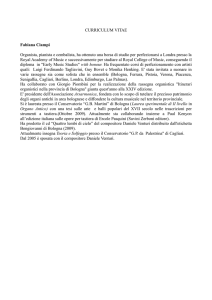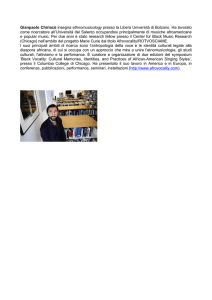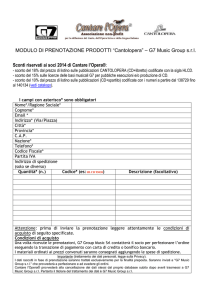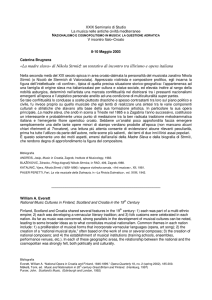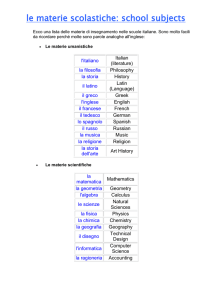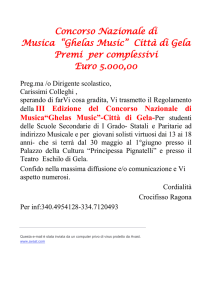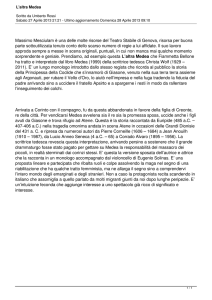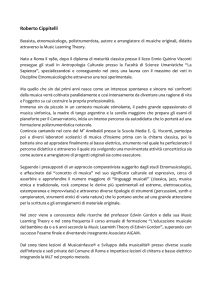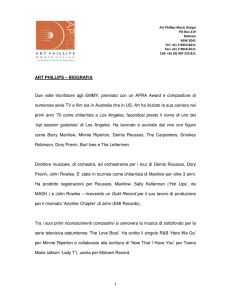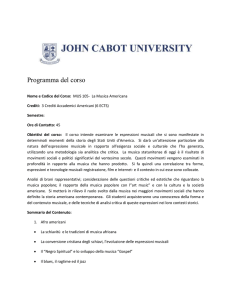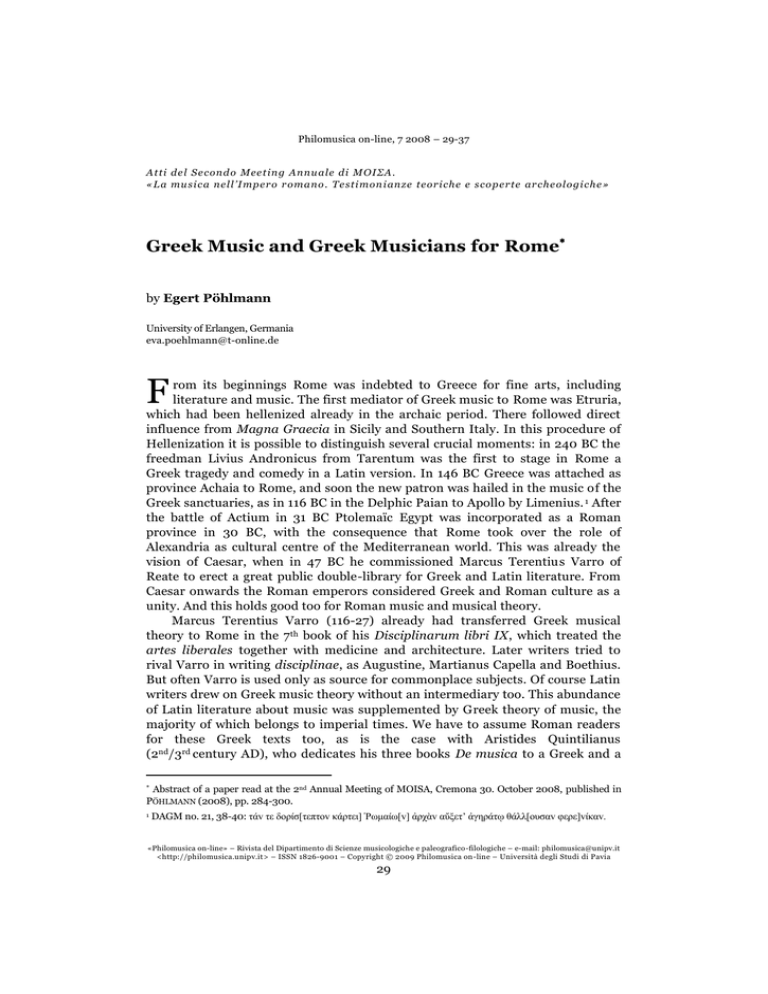
Philomusica on-line, 7 2008 – 29-37
A t t i de l Se cond o Mee t in g Annu ale d i M OI ΣA .
« La mu si ca nel l ’I mpe ro r omano . Tes ti mon i anze teo ri che e s co per te ar che ol o gi ch e»
Greek Music and Greek Musicians for Rome
by Egert Pöhlmann
University of Erlangen, Germania
[email protected]
F
rom its beginnings Rome was indebted to Greece for fine arts, including
literature and music. The first mediator of Greek music to Rome was Etruria,
which had been hellenized already in the archaic period. There followed direct
influence from Magna Graecia in Sicily and Southern Italy. In this procedure of
Hellenization it is possible to distinguish several crucial moments: in 240 BC the
freedman Livius Andronicus from Tarentum was the first to stage in Rome a
Greek tragedy and comedy in a Latin version. In 146 BC Greece was attached as
province Achaia to Rome, and soon the new patron was hailed in the music of the
Greek sanctuaries, as in 116 BC in the Delphic Paian to Apollo by Limenius. 1 After
the battle of Actium in 31 BC Ptolemaïc Egypt was incorporated as a Roman
province in 30 BC, with the consequence that Rome took over the role of
Alexandria as cultural centre of the Mediterranean world. This was already the
vision of Caesar, when in 47 BC he commissioned Marcus Terentius Varro of
Reate to erect a great public double-library for Greek and Latin literature. From
Caesar onwards the Roman emperors considered Greek and Roman culture as a
unity. And this holds good too for Roman music and musical theory.
Marcus Terentius Varro (116-27) already had transferred Greek musical
theory to Rome in the 7th book of his Disciplinarum libri IX, which treated the
artes liberales together with medicine and architecture. Later writers tried to
rival Varro in writing disciplinae, as Augustine, Martianus Capella and Boethius.
But often Varro is used only as source for commonplace subjects. Of course Latin
writers drew on Greek music theory without an intermediary too. This abundance
of Latin literature about music was supplemented by Greek theory of music, the
majority of which belongs to imperial times. We have to assume Roman readers
for these Greek texts too, as is the case with Aristides Quintilianus
(2nd/3rd century AD), who dedicates his three books De musica to a Greek and a
Abstract of a paper read at the 2nd Annual Meeting of MOISA, Cremona 30. October 2008, published in
PÖHLMANN (2008), pp. 284-300.
1
DAGM no. 21, 38-40: ηάv ηε δoρίζ[ηεπηov κάρηει] Ῥωμαίω[v] ἀρτὰv αὔξεη’ ἀγηράηῳ θάλλ[oσζαv θερε]vίκαv.
«Philomusica on-line» – Rivista del Dipartimento di Scienze musicologiche e paleografico-filologiche – e-mail: [email protected]
<http://philomusica.unipv.it> – ISSN 1826-9001 – Copyright © 2009 Philomusica on-line – Università degli Studi di Pavia
29
Philomusica on-line 7 (2008)
Roman friend, Eusebios and Florentius. Summing up, there seems to be some
coexistence of Greek and Latin music theory in Roman times, which is in keeping
with the bilingual character of the culture of the Roman empire outlined above.
Where musical practice is concerned, the picture is wholly different: up to
now there have been published 22 fragments with Greek musical notation from
classic or hellenistic times, and 40 fragments with Greek musical notation and
Greek text from imperial times. 2 Although the system of Greek notation was
alredy known in Rome in the late Republic,3 there exists no fragment of music
with Latin text. In order to fill this gap Günter Wille compiled an abundance of
literary, archaeological, organological, epigraphic and numismatic testimonies. 4
This impressive material bears witness to the prominent role of music in Rome,
but does not reveal anything about the music itself. But there remains the
possibility of looking around in the musical fragments with Greek text of imperial
times in order to find ‘Greek music for Romans’.
The first candidate is obviously the Greek musician and poet, Mesomedes of
Crete, a freedman and composer of citharodic nomoi at the court of Hadrian.5 It
is possible to reconstruct a collection of 18 of Mesomedes’ compositions, of which
five were transmitted with musical notation. There is nothing in Mesomedes
which is not familiar in the Greek poetry, metre and music of imperial times. 6 His
preference for stichic metres, as in the Hymn to the Sun or the Hymn to Nemesis
at the expense of strophic forms can be paralleled in Latin poetry by comparing
the choruses, monodies and lyric dialogues of Seneca. So far as the music is
concerned, the disappearance of the enharmonic genres, which were favourites in
the classical period, and the abandonment of the chromatic genres, which were
familiar in Hellenistic times, are characteristics of all fragments of Greek music in
imperial times. When Mesomedes is mirroring the prosody of his texts in his
melodies, he follows a habit already familiar in hellenistic music. Most interesting
is the possibility that Mesomedes composed new music for old texts as for the
three Prooimia and Ariphron’s On Health, perhaps wishing to give his eclectic
collection an archaising flavour.
There is evidence in imperial times for selections of miscellaneous solo
pieces with musical notation in the Mesomedes collection (DAGM 24-31), in the
anthologies of the Oxyrhynchus Monody (DAGM 38), the Oslo papyrus
(DAGM 39-40), the Yale Nomoi (DAGM 41) and the Michigan papyrus
(DAGM 42-43). The genres are different: while Mesomedes, the Oxyrhynchus
Monody and the Yale Nomoi belong to citharodia, the pieces in the Oslo papyrus
and the Michigan papyrus are tragoedia, tragic solo song. Mesomedes seems to
2
DAGM nos. 1-22; 23-61; Pap. Louvre E 10534: BÉLIS (2004), WEST (2007).
Cicero Tusculanae disputationes 4, 2, 3, Livius Ab urbe condita 7, 2, 7, Varro fr. 282 Funaioli; WILLE
(1967), pp. 489-490.
3
4
WILLE (1967).
5
Suda s.v. Μεζoμέδης (Μ 668) Adler.
6
See WEST (1982), pp. 162-185; WEST (1992), pp. 372-385.
30
Egert Pöhlmann – Greek Music and Greek Musicians for Rome
have recomposed the old texs of Ariphron’s Hymn to Hygieia and the three
Prooemia, and recomposition is to be assumed too for the monody of
Oxyrhynchus and the Yale Nomoi. In the case of the Oslo papyrus and the
Michigan papyrus soloists have set spoken verse, anapaests and iambic trimeters,
to music, using for the three prologues texts of older tragedies. Of course
citharody was performed and accompanied by only one soloist. But the two
prologues in the form of dialogues of the Michigan papyrus require a secondary
actor assisting in the performance, while the instrumental interlude in the first
prologue of the Michigan papyrus attests the presence of an aulos-player in the
performance. We have to assume the same ways of adapting material for solo
performances in Roman musical life.
In the prologues of the Oslo and Michigan Papyri it is evident that a
composer of imperial times has set to music iambic trimeters, spoken verse which
was never intended to be sung. This could not have happened until the feeling for
the intrinsic differences of spoken and sung verses had been lost. This was true
for Latin poetry, where elegies, eclogues, sapphic odes, hendecasyllabi were sung
without discrimination of the genres from the neoteric poets to imperial times. In
Petronius (Cena Trimalchionis 64, 2) there is evidence that canturire diverbia,
adicere melica was usual in symposia.
In the case of the emperor and musician Nero, there is ample information
about the performances of this imperial amateur. Nero started his career as
citharoedus in Rome at the Iuvenalia in 59 AD. But later Nero competed in
Greece as tragoedus too,7 singing in tragic costume and mask solo pieces for male
and female roles.8 Of course Nero, accompanying himself, performed his
citharodies alone. For his tragic scenes he might sometimes have used a
secondary actor, e.g. in the case of the Oedipus excaecatus, who needed a guide.
Moreover, as in tragic scenes an aulos player was obligatory, the tragoedus
needed an assisting musician, whose interlude we have found in the Michigan
papyrus. Summing up, the citharoedus turns out to be a real soloist, while the
tragoedus was the leading part in a little ensemble scene. Finally, there is
evidence for an anthology of Neronian musical highlights for solo performance,
the dominicum, which is mentioned by Suetonius. 9
Fragments of Greek Music in papyri as well as literary testimonies furnish a
vivid picture of musical practice in Imperial times. It seems that the recently
published fragment of a Medea,10 which is transmitted on a Louvre papyrus of the
2nd century AD, has to be understood against this background. The text of its lines
1-14 consists without exception of iambic trimeters. Of line 15 only some musical
7
Suetonius Nero 22, 3; Dio Cassius 63, 9, 1 f.; ibid. 14, 4; WILLE (1967), pp. 344-345, nn. 435-436.
Suetonius Nero 21, 3: tragoedias quoque cantavit personatus heroum deorumque, item heroidum ac
dearum, personis effectis ad similitudinem oris sui et feminae, prout quamque diligeret. WILLE (1967), pp.
342-345.
8
9
Suetonius Vitellius 11.
10
Louvre, inv. nr. E 10534; BÉLIS (2004).
31
Philomusica on-line 7 (2008)
signs survive. Lines 1-2 may be attributed to Jason, lines 6-11 to Creon, while
lines 3-5 and 12-15, which are furnished with musical notation, belong to Medea,
who defends herself against the accusation that she had killed their children.
Aristotle11 gives evidence that the text of the Louvre Medea fragment belongs to
the Medea of Carcinus the Younger (floruit 380-377 BC).12
Martin L. West,13 after having improved fundamentally the reconstruction of
the text, demonstrated that the music of the lines of Medea cannot be a
composition of the 4th century BC. The florid style of the melody, which can be
seen in lines 4-5 and the pure diatonic ionic key alone point to imperial times.
The fact that lines 3-5 and 12-15 are spoken verse, which were set to music later,
connects the Louvre Medea with the Oslo and Michigan papyri, which belong to
imperial times too (see above). Finally, the Louvre Medea is connected with the
two prologues of the Michigan papyrus (DAGM 42-43) in so far as it again
displays an ensemble scene, but with a difference: while in DAGM 42 there is
evidence for two singing actors and an aulos player, the Louvre Carcinus is
performed by one singing soloist, Medea, and two speaking actors, Iason and
Creon. This way of tragoediam cantare comes very close to Nero’s performances
on stage with the assistance of one or two hypocritae. Taking all these points
together, it becomes evident that the Louvre papyrus presents spoken trimeters
of Jason, Creon and Medea from the 4 th century BC, which were adapted for a
solo performance by setting the part of Medea to music in imperial times.
After this survey it must be admitted that in imperial times it does not make
sense to search for genuine Roman versus genuine Greek music, as Günther Wille
attempted in vain. The Greek musical papyri as well as the literary evidence for
Roman music bear witness of a process of mutual assimilation of Greek and
Roman music, which began early in republican times. The result of this evolution
in imperial times was a Greco-Roman musical idiom, a common musical
language, the elements of which were handed down to posterity.
***
Musica e musicisti greci per Roma
Fin dai primordi, Roma fu in debito con la Grecia per quel che riguarda le belle
arti, incluse la letteratura e la musica. Il primo mediatore per la musica greca a
Roma fu l’Etruria, che si era ellenizzata già in epoca arcaica. Seguirono influenze
dirette dalla Magna Graecia, in Sicilia e nel Sud-Italia. In tale processo di
ellenizzazione è possibile distinguere diversi momenti cruciali: nel 240 a.C. il
liberto Livio Andronico di Taranto fu il primo a mettere in scena a Roma una
11
Aristotle Rhetorica 1400b8 = Carcinus II TrGF 70 F 1e.
12
Carcinus II TrGF 70.
13
WEST (2007).
32
Egert Pöhlmann – Greek Music and Greek Musicians for Rome
tragedia o commedia greca in versione latina. Nel 146 a.C. la Grecia fu annessa a
Roma come provincia Acaia e presto il nuovo patrono fu salutato
entusiasticamente nelle musiche per i santuari greci, come avvenne nel 116 a.C.
nel peana delfico per Apollo composto da Limenio.1 Dopo la battaglia di Azio del
31 a.C., nel 30 a.C. l’Egitto Tolemaico venne incorporato come provincia romana,
con la conseguenza che Roma rilevò il ruolo che era stato di Alessandria quale
centro culturale del mondo Mediterraneo. Questa era già la visione di Cesare,
quando nel 47 a.C. commissionò a Marco Terenzio Varrone di Rieti l’incarico di
allestire una grande biblioteca doppia per la letteratura greca e latina. Da Cesare
in poi, gli imperatori romani considerarono la cultura greca e romana come
un’unità, e questo vale anche per la musica e la teoria musicale romana.
Marco Terenzio Varrone (116-27) aveva già trasferito la teoria musicale greca
a Roma nel settimo libro del suo Disciplinarum libri IX, che trattava le artes
liberales assieme a medicina e architettura. Scrittori successivi tentarono di
rivaleggiare con Varrone nello scrivere disciplinae, come Agostino, Marziano
Capella e Boezio. Ma spesso Varrone è utilizzato unicamente quale fonte per
argomenti piuttosto banali. Certamente gli scrittori latini attinsero alla teoria
musicale greca anche senza bisogno di intermediazioni. Questa abbondanza di
letteratura latina sulla musica si integrava con la teoria musicale greca, la
maggior parte della quale appartiene all’epoca imperiale. Per questi testi greci
dobbiamo infatti presumere anche lettori romani, come è il caso di Aristide
Quintiliano (II/III sec. d.C.), che dedica i suoi tre libri De musica a un amico
greco e a uno romano, Eusebio e Florenzio. Per riassumere, sembra esserci stata
una certa coesistenza di teoria musicale greca e romana all’epoca di Roma, in
linea con il carattere bilingue della cultura dell’Impero Romano sopra delineato.
Se si parla di pratica musicale, il quadro è completamente differente: a
tutt’oggi sono stati pubblicati 22 frammenti con notazione musicale greca d’epoca
classica o ellenistica, e 40 frammenti con notazione musicale e testo greci di età
imperiale.2 Pur se il sistema di notazione greca era già conosciuto a Roma nella
tarda Repubblica 3, non esiste alcun frammento di musica con testo latino. Per
riempire questo vuoto Günter Wille ha raccolto una abbondante serie di
testimonianze letterarie, archeologiche, organologiche, epigrafiche
e
numismatiche.4 Questa impressionante mole di materiale testimonia certo il
ruolo preminente della musica a Roma, ma non rivela nulla sulla musica in sé.
Rimane però la possibilità di investigare i frammenti musicali con testo greco
d’età imperiale allo scopo di trovare ‘musica greca per romani’.
1
DAGM n. 21, 38-40: ηάv ηε δoρίζ[ηεπηov κάρηει] Ῥωμαίω[v] ἀρτὰv αὔξεη’ ἀγηράηῳ θάλλ[oσζαv θερε]vίκαv.
2
DAGM nn. 1-22; 23-61; Pap. Louvre E 10534: BÉLIS (2004), WEST (2007).
Cicerone Tusculanae disputationes 4, 2, 3, Livio Ab urbe condita 7, 2, 7, Varrone fr. 282 Funaioli; WILLE
(1967), pp. 489-490.
3
4
WILLE (1967).
33
Philomusica on-line 7 (2008)
Il primo candidato è ovviamente il musicista e poeta greco Mesomede di Creta,
liberto e compositore di nomoi citarodici alla corte di Adriano.5 È possibile
ricostruire una collezione di 18 composizioni di Mesomede, cinque delle quali
furono trasmesse con notazione musicale. Non vi è nulla in Mesomede che non sia
familiare alla poesia, alla metrica e alla musica greca d’età imperiale.6 La sua
preferenza per i versi stichici, come nell’ Inno al Sole o nell’ Inno a Nemesi, a
scapito delle forme strofiche può trovare un parallelo nella poesia latina se messi a
confronto con i cori, le monodie e i dialoghi lirici di Seneca. Per quel che riguarda la
musica, la scomparsa del genere enarmonico, favorito nel periodo classico, e
l’abbandono del genere cromatico, familiare in età ellenistica, sono caratteristiche
di tutti i frammenti di musica greca d’epoca imperiale. Quando Mesomede
rispecchia nelle proprie melodie la prosodia dei suoi testi, egli segue una
consuetudine che era stata familiare alla musica ellenistica. Alquanto più
interessante è invece la possibilità che Mesomede avesse composto nuove musiche
per testi antichi, come per i tre Prooimia e per il componimento Sulla salute di
Arifrone, forse allo scopo di dare alla sua eclettica collezione un sapore arcaizzante.
In epoca imperiale sono testimoniate selezioni di brani solistici miscellanei
con notazione musicale nella collezione di Mesomede (DAGM 24-31), nelle
antologie della Monodia di Ossirinco (DAGM 38), nel papiro di Oslo
(DAGM 39-40), nei Nomoi di Yale (DAGM 41) e nel papiro Michigan
(DAGM 42-43). I generi si differenziano: mentre Mesomede, la Monodia di
Ossirinco e i Nomoi di Yale appartengono alla citharodia, i brani nei papiri di
Oslo e Michigan sono tragoedia, canti solistici tragici. Mesomede sembra aver
nuovamente musicato gli antichi testi dell’inno Sulla salute di Arifrone e dei tre
Prooimia, e si devono supporre ricomposizioni anche per la Monodia di Ossirinco
e i Nomoi di Yale. Nel caso dei papiri di Oslo e Michigan i solisti hanno adattato
versi solitamente recitati, quali anapesti e trimetri giambici, alla musica, usando
per i tre prologhi testi di tragedie più antiche. Certamente la citarodia era
eseguita e accompagnata da un unico solista. Ma i due prologhi in forma di
dialogo del papiro Michigan richiedono un secondo attore che prenda parte alla
performance, mentre l’interludio strumentale del primo prologo del papiro
Michigan attesta la presenza nell’esecuzione di un suonatore di aulos. Dobbiamo
presupporre le stesse modalità di adattamento del materiale per quel che
riguarda le esibizioni solistiche nella vita musicale romana.
Nei prologhi dei papiri di Oslo e Michigan risulta evidente che è un
compositore d’epoca imperiale ad aver messo in musica i trimetri giambici, versi
recitati che non erano stati composti per essere cantati. Ciò non sarebbe mai
potuto accadere fino a che non si perse la percezione dell’intrinseca differenza
che vi era tra versi recitati e cantati. Ciò fu vero per la poesia latina, dove elegie,
egloghe, odi saffiche ed endecasillabi erano cantati senza discriminazioni di
5
Suda s.v. Μεζoμέδης (Μ 668) Adler.
6
Vd. WEST (1982), pp. 162-185; WEST (1992), pp. 372-385.
34
Egert Pöhlmann – Greek Music and Greek Musicians for Rome
genere dai poeti neoterici d’epoca imperiale. In Petronio (Cena Trimalchionis 64,
2) è testimoniato che canturire diverbia, adicere melica era usuale nei simposi.
Nel caso dell’imperatore e musicista Nerone, vi è un’ampia serie di
testimonianze sulle esibizioni amatoriali di questo imperatore. Nerone iniziò la
sua carriera come citharoedus a Roma agli Iuvenalia del 59 d.C. Ma
successivamente egli prese parte a competizioni in Grecia anche come
tragoedus,7 cantando in costume e maschera tragiche brani solistici per ruoli
maschili e femminili. 8 Certamente Nerone, accompagnandosi, eseguì da solo le
proprie citarodie, mentre per le sue scene tragiche egli poteva aver talora
utilizzato un secondo attore, ad esempio nel caso dell’Oedipus excaecatus, che
aveva bisogno di una guida. Inoltre, visto che nelle scene tragiche era obbligatorio
un suonatore di aulos, il tragoedus aveva bisogno di un musicista che lo
accompagnasse, e possiamo trovare un suo interludio nel papiro Michigan.
Quindi, mentre il citharoedus risultava essere un vero e proprio solista, il
tragoedus ricopriva il ruolo principale in una piccola scena d’insieme. Infine, è
testimoniata un’antologia di numeri musicali d’eccezione per una performance
solistica, il dominicum, menzionata da Svetonio. 9
I frammenti di musica greca su papiro e come testimonianze letterarie
delineano un quadro vivido della prassi musicale nel periodo imperiale. Sembra
che i frammenti recentemente pubblicati di una Medea,10 tramandata da un
papiro del Louvre del II sec. d.C., si debbano interpretare proprio alla luce di
questo quadro culturale. Il testo dei versi 1-14 è tutto in trimetri giambici, mentre
del verso 15 sopravvivono solo alcuni segni musicali. I versi 1-2 possono essere
attribuiti a Giasone, i versi 6-11 a Creonte, mentre i versi 3-5 e 12-15, corredati di
notazione musicale, appartengono a Medea, che si difende dall’accusa di aver
ucciso i propri figli. Aristotele 11 fornisce la testimonianza che il testo
frammentario della Medea del Louvre appartiene alla Medea di Carcino il
Giovane (floruit 380-377 a.C.).12
Martin L. West,13 dopo aver sostanzialmente migliorato la ricostruzione del
testo, ha dimostrato come la musica dei versi di Medea non possa essere una
composizione del IV secolo a.C. Lo stile fiorito della melodia, che si può
riconoscere ai versi 4-5, e la tonalità ionica diatonica pura puntano a una
collocazione del frammento in epoca imperiale. Il fatto che i vv. 3-5 e 12-15 siamo
versi recitati, messi in musica successivamente, collega la Medea del Louvre con i
7
Svetonio Nero 22, 3; Dione Cassio 63, 9, 1 f.; ibid. 14, 4; WILLE (1967), pp. 344-345, nn. 435-436.
Svetonio Nero 21, 3: tragoedias quoque cantavit personatus heroum deorumque, item heroidum ac
dearum, personis effectis ad similitudinem oris sui et feminae, prout quamque diligeret. WILLE (1967), pp.
342-345.
8
9
Svetonio Vitellius 11.
10
Louvre, inv. nr. E 10534; BÉLIS (2004).
11
Aristotele Rhetorica 1400b8 = Carcino II TrGF 70 F 1e.
12
Carcino II TrGF 70.
13
WEST (2007).
35
Philomusica on-line 7 (2008)
papiri di Oslo e Michigan, che appartengono anch’essi all’età imperiale. Infine, la
Medea del Louvre si collega anche ai due prologhi del papiro Michigan (DAGM
42-43), in quanto anch’essa mostra una scena d’insieme, ma con una differenza:
mentre in DAGM 42 sono testimoniati due attori che cantano e un suonatore di
aulos, il Carcino del Louvre è eseguito da un solo cantore solista, Medea, e da due
attori recitanti, Giasone e Creonte. Questa modalità di tragoediam cantare si
avvicina molto alle esibizioni di Nerone assistito da uno e due hypocritae.
Mettendo insieme tutte queste riflessioni, diventa evidente come il papiro del
Louvre presenti trimetri recitati di Giasone, Creonte e Medea originari del IV sec.
a.C., che furono poi adattati a performances solistiche grazie alla riscrittura
musicale della parte di Medea in età imperiale.
Da questo sguardo panoramico risulta evidente come, in epoca imperiale,
non abbia senso cercare una musica genuinamente romana che si contrapponga a
una musica genuinamente greca, come Günter Wille ha cercato invano di fare. I
papiri musicali greci e l’evidenza letteraria di una musica romana testimoniano
un processo di mutua assimilazione della musica greca e romana, iniziato sin
dall’epoca repubblicana. Il risultato di questa evoluzione in età imperiale fu un
idioma musicale greco-romano, un linguaggio musicale comune, i cui elementi
furono poi tramandati ai posteri.
36
Egert Pöhlmann – Greek Music and Greek Musicians for Rome
Bibliography
ANNIE BELIS (2004), Un papyrus musical inédit au Louvre (Pap. Louvre E 10534),
«Comptes rendus de l’Académie des Inscriptions et Belles-Lettres», 3, pp. 1305-1329.
CARCINUS II Fragmenta, in Tragicorum Graecorum Fragmenta, vol. 1 (1986): Didascaliae
Tragicae, Catalogi Tragicorum et Tragoediarum, Testimonia et Fragmenta
Tragicorum Minorum, hrsg. von Bruno Snell und Richard Kannicht, Gottingen,
Vandenhoeck & Ruprekt (TrGF).
EGERT PÖHLMANN (2008), Gegenwärtige Vergangenheit, Berlin, W. de Gruyter.
EGERT PÖHLMANN – MARTIN L. WEST (2001), Documents of Ancient Greek Music. The extant
melodies edited and transcribed with commentary, Oxford, Clarendon Press (DAGM).
VARRO, in Grammaticae Romanae fragmenta (1907), collegit recensuit Hyginus Funaioli,
Lipsiae, Teubner (rist. Roma, L’erma di Bretschneider, 1964).
MARTIN L. WEST (1982), Greek Metre, Oxford, Clarendon Press.
MARTIN L. WEST (2007), A New Tragic Papyrus with Music, «Zeitschrift für Papyrologie und
Epigraphik», 161, pp. 1-10.
GÜNTER WILLE (1967), Musica Romana: die Bedeutung der Musik im Leben der Römer,
Amsterdam, Schippers.
Egert Pöhlmann ha ricoperto la prima cattedra di Studi Classici all’Università di Erlangen
(Germania) fino al 2001. Oltre a volumi monografici e articoli specialistici sul mondo greco e
romano e sulla musica nel mondo antico, ha pubblicato contributi che evidenziano
collegamenti tra gli studi classici e discipline affini come la filosofia antica, l’archeologia, la
storia dell’arte e la letteratura e la musica tedesche moderne.
Egert Pöhlmann held the Chair I of Classical Studies at the University of Erlangen
(Germany) until 2001. As well as books and papers on Greek and Latin Studies and music in
Antiquity, he published contributions seeking links between topics in Classical Studies and
neighbouring disciplines such as antique philosophy, archaeology, art history, modern
German literature and music.
37

